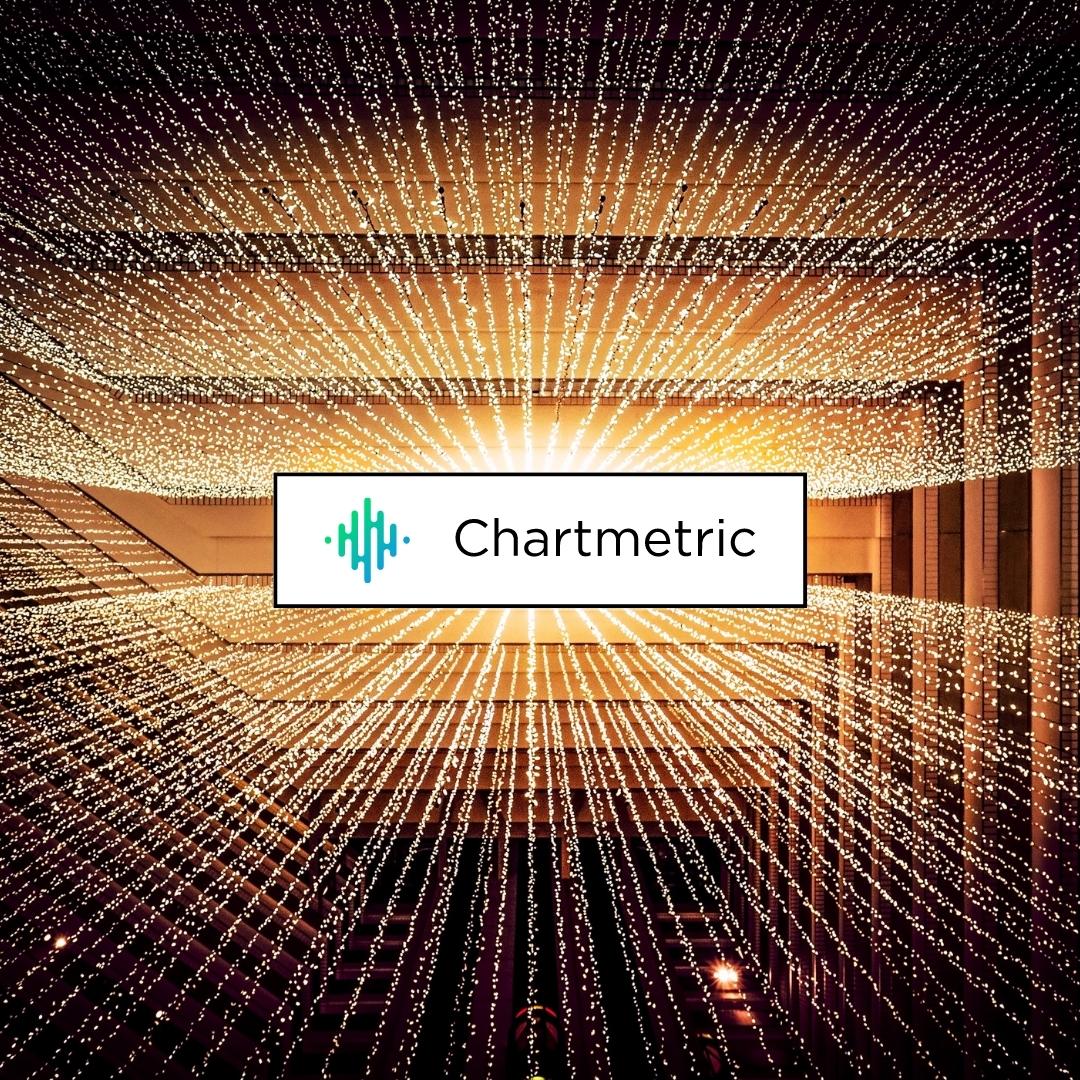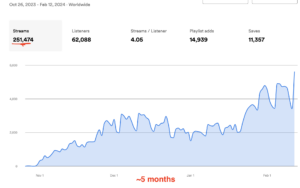Is Chartmetric worth it?
Here’s my quick answer that you might not like:
It depends on what you’re looking for.
From a pure functionality standpoint, oh yeah, it’s worth it. Chartmetric is the best tool I’ve found for compiling a huge range of data across a bunch of different platforms. From a sheer stats perspective, it’s incredible. It has information on artists, playlists, and songs that I didn’t even think to look for before I saw it in their dashboard. And it’s all presented beautifully.
But from the standpoint of utility, the question gets a little bit harder for me. Personally, I’m on the fence about continuing my $10 / month artist plan, because I’m having trouble answering the real question that sits at the next level down: “How am I using this tool?” Sometimes, I feel like I’ll waste an hour combing through mountains of data without any real purpose. And in that case, is it really worth it?
In this post, I’ll breakdown what Chartmetric does well – and, crucially, how you can actually use it to further your music career. Hopefully, in doing so, you’ll come to a better understanding of whether this crazy-capable tool is worth it for you.
Let’s dig in.
What is Chartmetric?
Okay, we’ll back up a step first and cover the foundation: What actually is Chartmetric?
It’s a lot of things, which makes it rather hard to sum up, but here’s the attempt they offer on their homepage: “Chartmetric is the all-in-one platform for artists and music industry professionals, providing comprehensive streaming, social, and audience data for everyone to create successful careers in music.”
Maybe a good way to think about it is as a music industry data dashboard. You know how every platform has its own analytics section? Chartmetric is basically what happens when you smash them all together, throw in additional data that some platforms don’t provide, and make everything pretty.
Here are some of the features the platform offers. (This is a very limited set, because they offer so many data points that it’d take a book to cover everything.)
- Artist overview (see general fanbase stats on any artist across platform)
- Artist track comparison (see how an artist’s songs compare to other songs)
- Artist comparison (see how an artist compares to other artists)
- Playlist overview (see pretty much all of the data you could want on a playlist, including follower growth, genre information, track popularity score, days of the week the list is updated, and more)
- Curator overview (see basic data on playlist curators)
- Information from Spotify, YouTube, TikTok, Instagram, Wikipedia, radio, Deezer, Apple Music, Amazon Music
Visually, here’s how Chartmetric breaks their feature set down. This is literally a screenshot of the dropdown menu under the “Features” item on their website:
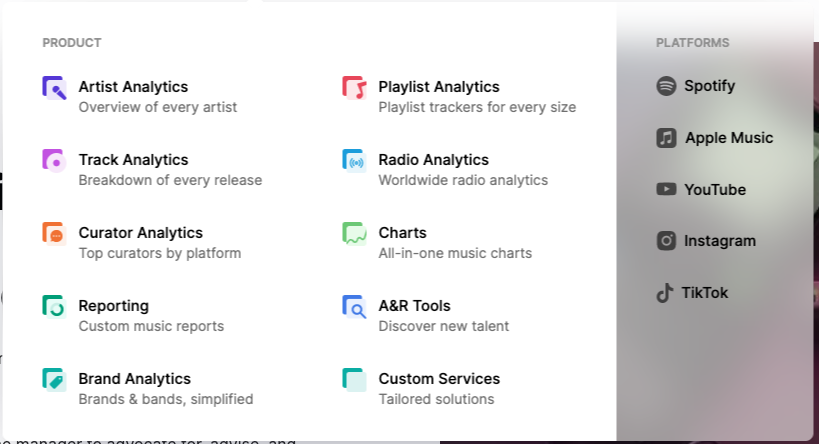
It’s a ton of stuff. Frankly, the breadth of data and the range of functionality Chartmetric offers blows away competitors – at least the ones that I’ve tried, like SpotonTrack and Soundcharts. (A quick Google search turned up a new company called Viberate, which looks like it might be a closer match to Chartmetric’s capabilities.)
Which leads to an obvious next question:
How much does Chartmetric cost?
From what I’ve seen, Chartmetric pricing has fluctuated a lot.
They started out fairly reasonably – I think the product was $15 a month at first. Then, as they homed in on a target market, they started to bump up the price. This made sense, because the product was geared mainly toward users with money: the labels, the A&Rs, the supervisors, and basically any of the music industry folks who wear suits and sunglasses and are in a perpetual search for hands to shake.
As a result, at one point not too long ago, the company bumped up the plan in a huge way, and the only option to access most Chartmetric features was to pay $140 / month.
As you might expect, there was backlash against that price hike. Competitors started using comparison-based marketing (“Priced out by Chartmetric? We’re only $10 / month!”)
In response, Chartmetric recently put out a pricing tier they call the Artist Plan. It’s honestly a great deal that brings things back to a realistic level for most artists: $10 / month.
Here are the options as things stand today:
| Free Plan | Artist Plan | Premium Plan |
|---|---|---|
| $0 (obviously) | $10 / month | $140 / month |
The main difference between plans is how much data you have access to. Free users get a pretty limited dashboard. Artist Plan users can see comprehensive data on one artist, but other artists will have some inaccessible sections, and there are a few advanced areas, like Playlist Journeys, that aren’t available.
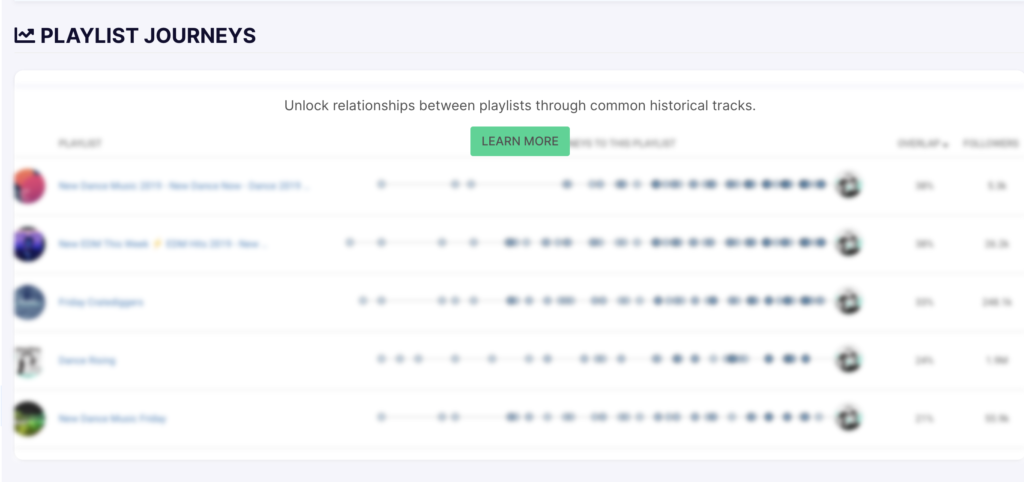
Premium users have access to everything.
Here’s the link to Chartmetric’s pricing page if you want to check things yourself.
How should you use Chartmetric?
This is the big question that ultimately determines whether or not the product is right for you.
Truthfully, there are a million and one ways you could use this platform. But if you’re an artist, then you’re presumably looking to grow your fanbase, and assuming that use case, here are a few tactics I think are cool.
1. Find artists to collaborate with.
This is actually the use case the Chartmetric showcases on their landing page for Artist Managers, and I think it’s a sweet one: Search by a certain city, then comb through the local artists to find similar acts.
For instance, I’m based in Denver, Colorado. Chartmetric has a page on our city, complete with a list of top artists:
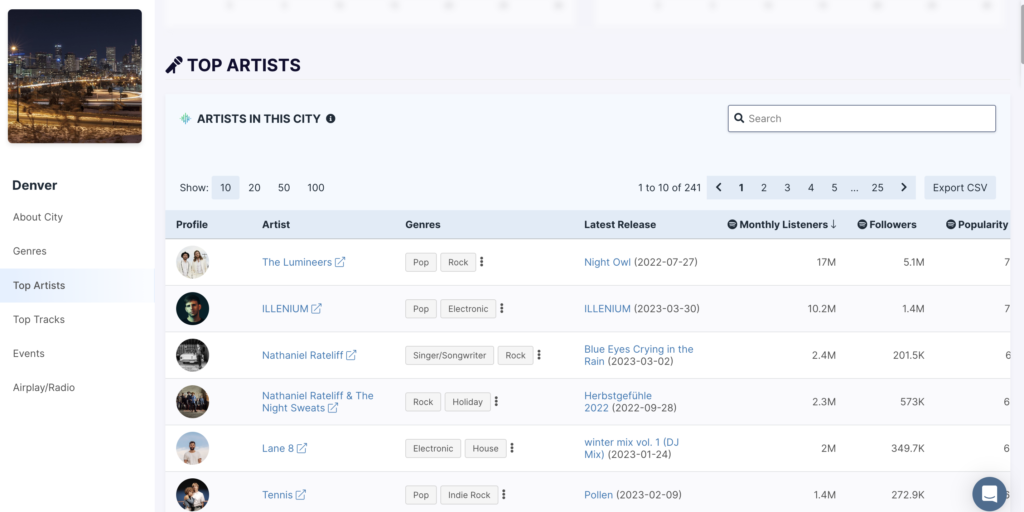
I’m probably not going to be able to co-write with The Lumineers, but if I click through a few pages, I can probably find some local acts that would be worth working with. You can also use the search bar (pictured in that screenshot) to filter by genre. So, for example, if I type in “folk,” I can see a list of the artists who are in my genre range.
If you’re looking to co-write, or if you want to book shows in a city and need an opener (or a co-headliner) to fill a venue, this is a valuable tool.
Of course, these days, you definitely aren’t limited to working with artists in your city. Chartmetric could also be put to use to find far-flung collaborators.
For instance, they have a chart they call “Neighboring Artists” – basically, these are artists with similarly-sized fanbases, according to Chartmetric’s data across platforms. Again, you can filter by genre, so you could conceivable pick 10 artists who are a few steps above you and reach out about collaborating.
All of this would take work, and it might not beat natural networking at your own music scene. But it also has the potential to be super helpful and broaden your horizons past what you’d be able to accomplish otherwise.
2. Find curators to pitch your music to.
This is the first thing I thought of using Chartmetric for. I’ve done a lot of work in playlist pitching, and I originally signed up for Chartmetric to see if they’d be a good platform for finding playlist curators.
Chartmetric has a listing page specifically dedicated to top curators:
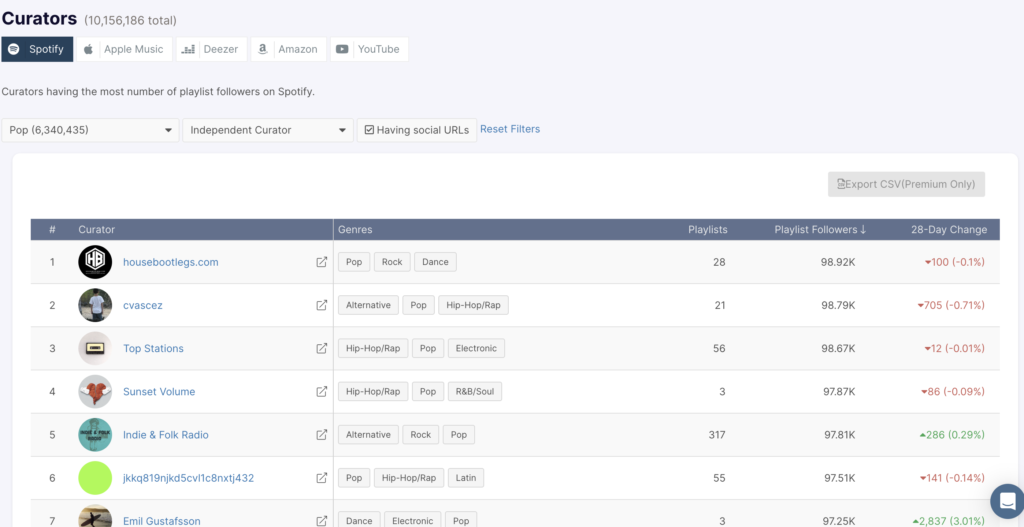
You can filter by genre, platform, and type of curator (i.e., independent, major label, platform-owned). So, an easy use case is to pick your genre and platform, then start scrolling through curators to see if any might be worth submitting your music to.
Chartmetric has a wealth of data, but this is one area where I think they fall a little short compared to alternatives like Artist Tools or Playlist Supply, which are created more specifically for this type of work.
Also, they only offer 10,000 rows of data on the Artist Plan. This might seem like a lot, but once you add in specific search criteria, you run out of room pretty quickly. For example, if I plug in filtering for third-party folk curators with social handles, I blow through all of the rows and don’t get any results.

3. Evaluate the quality of the playlists that you’re on (or the ones you’re considering pitching to).
In terms of playlist data, though Chartmetric is probably the best in the business. They offer pretty much everything you could want to know about a playlist, including:
- Followers (total and over time)
- Number of tracks (total and over time)
- Days tracks are usually added and removed
- Average newness of added tracks
- Average time tracks are on the playlist
- Average popularity score of tracks on the playlist
- The record labels represented by tracks on a playlist
- Genres
- Countries
- Similar playlists
They also have a section called Playlist Journeys that purports to show how users reach a specific playlist. This could be really helpful for finding similar playlists, but you have to pony up $140 a month for it; it’s only available on the premium plan.
Still, with what you get for $10 / month as an artist, you definitely have enough to tell if a playlist is legitimate, and to ascertain if it’d be worth your time to submit your music to the relevant curator.
4. Track the effectiveness of your marketing campaigns.
Admittedly, this is one use case I haven’t tried myself (even though I probably should).
Picture this: You pay an agency to run a multi-faceted campaign. They get you a few radio plays, several press articles, and inclusion on a few Spotify playlists. Nice work, right?
Hopefully that’s right – but with Chartmetric, you can confirm the results and see how they might translate to other platforms.
Chartmetric has an overall artist score that shows some semblance of your overall popularity. Their ability to pull together so many disparate streams of data can let you track the effectiveness of your marketing with more clarity.
For example, when you got radio spins, did your Spotify numbers go up at the same time? When you got that write-up in American Songwriter, did your streams increase at all? And how did your artist rank change over time?
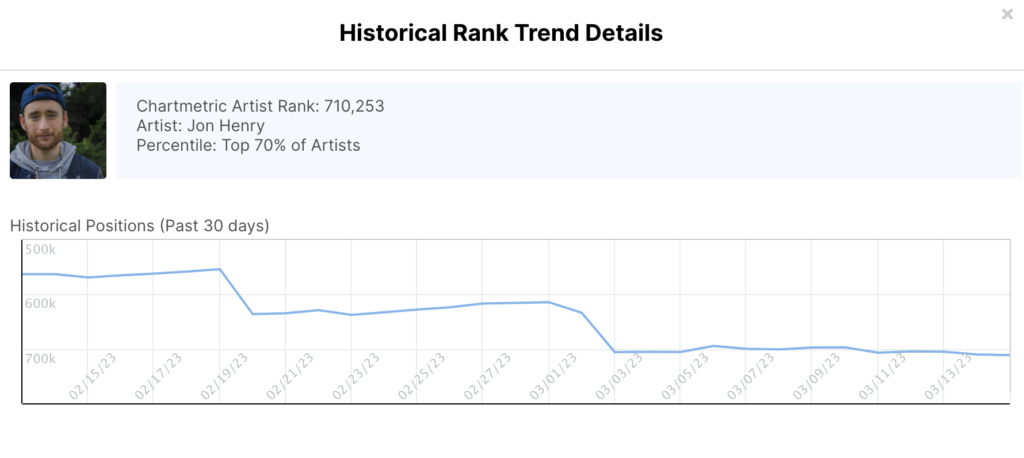
This is a great way to measure marketing performance. (If you ever think to look, of course.)
5. Compare yourself to other artists so you can feel bad.
This is kind of a joke. But honestly, this is why I’m currently leaning toward cutting Chartmetric from my tech stack: I just struggle to use it without comparing myself or the artists I work with to other, more popular acts.
In itself, the ability to measure against others isn’t bad. It can be helpful to see how other artists are doing; you can use their strategies as starting points for your own.
But it’s tough to do this without feeling some sort of envy – at least, it’s tough for me ha.
The final verdict on Chartmetric
Overall, Chartmetric is a thoughtfully-designed software that provides a ton of potentially-helpful data.
For corporate music industry people, I think it’s kind of a no-brainer if you’ve got the budget for it. There’s so much you could do with this information that would be harder to do in the dark.
For artists, I think it’s a harder call. Chartmetric is a do-it-all dashboard. That’s great, but it can also feel overwhelming, and in some highly actionable areas (like playlist pitching), there are other tools that solve specific pain points a little better.
Still, $10 / month is a crazy deal for the data you’re getting. My honest recommendation would be to give it a shot and see if you use it, then evaluate after a few months whether or not it’s worth keeping.
Which brings me back to my initial take: It all depends on how you use it.
You can give Chartmetric a try here.
And whatever you do, here’s wishing you good luck.

